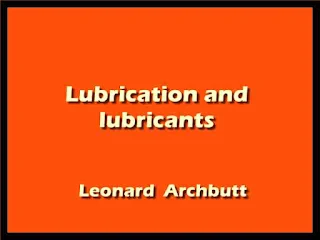Lubrication and lubricants
A treatise on the theory and practice of lubrication, and on the nature, properties, and testing of lubricants
Although the subject of lubrication and lubricants is by no means unrepresented in our technical literature, we are not acquainted with anyone work in which it is adequately treated, in the light of our present knowledge, from the point of view of the engineer and also of the chemist.
Nevertheless, it was not without considerable hesitation that we accepted the invitation of the publishers to write a treatise on the subject. So much still remains to be learned, relating to the chemical constitution and physical properties of lubricants, and also regarding the manner in which they act, under certain circum- stances, in reducing friction, that we cannot claim to have produced a complete treatise.
We trust, however, that our work, though necessarily incomplete in many respects, will prove of value to the engineer, the chemist, and the manufacturer. Being the joint production of a chemist and an engineer, the responsibility for the chemical and mechanical sections of the work must necessarily rest mainly upon one or other of the authors; the purely physical sections are, however, to a large extent of joint authorship.
Our object has been to, as far as possible, make each section complete in itself. In the first four chapters, friction, the viscosity of liquids, such lubrication are treated mainly from a theoretical point of view; in the five succeeding chapters, the nature, properties, and testing of lubricants are dealt with ; and the two final chapters are devoted to a description and discussion of the practical application of lubricants to machinery for the purpose of reducing friction and wear. In the last chapter, which has been written chiefly for engineers in charge of machinery, many points are again briefly discussed which have already been more fully treated in earlier portions of the work.
The descriptions of oil-testing machines in the chapter on the mechanical testing of lubricants are based almost entirely on published information; but, in the instructions for their manipulation, an endeavour has been made to state the conditions under which tests may be made for "oiliness" or for viscosity, much that has been written on the subject being unsound, owing to a want of knowledge concerning the conditions under which these two properties of lubricants are of active value.
For the theory of viscous lubrication we are indebted, firstly to the experimental work carried out for the Institution of Mechanical Engineers by Mr Beauchamp Tower, and secondly, to the theoretical explanation of Mr Tower's results communicated to the Royal Society by Professor Osborne Reynolds, F.RS. Without losing sight of the valuable work done by other investigators, amongst whom should be mentioned Professors Thurston and Goodman, also Mr Veitch Wilson, who, as a manufacturer, has laboured for so many years to spread a correct knowledge of the nature and properties of lubricants among users, it is not too much to say that the work done by Mr Keauchamp Tower and Professor Osborne Reynolds has been mainly instrumental in loading to the adoption of scientific methods of lubrication, and has enabled the part played by the viscosity of the lubricant to be clearly stated. An equally complete treatment of the theory of oiliness or greasiness is at present impossible: but the bearing upon this important branch of the subject of the investigations on the stability and thickness of liquid films carried out by Professors Reinold and Eiicker has been called attention to. Lord Rayleigh's contributions to the theory of superficial forces have also enabled us to show tlie important part played by superficial tension.
The adoption of more correct ideas concerning the theory of lubrication, and the demand for machines of greater efficiency and power, have led to very rapid improvements in the designs of bearings and in the methods of applying lubricants. Since we undertook to write this work, great progress has been made in this direction. Every endeavour has been made to give the latest practical information, and we trust that, in giving prominence to new designs, we shall not be regarded as having passed over with undue haste older methods and principles which still commend themselves to many practising engineers.
book details : Download Lubrication and lubricants - 22.6 MB

